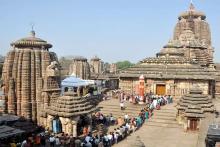
The Lingaraj Temple, located in the city of Bhubaneswar, is an ancient and the largest temple in the city. Dedicated to Lord Shiva, it was constructed in the 7th century by King Jajati Keshari.
This temple holds immense reverence due to the belief that the Linga, representing Lord Shiva, manifested naturally within it. The Linga stands at an impressive height of 8 inches above the temple floor and has a diameter of about 8 feet. Situated in the old part of Bhubaneswar Town, Lingaraj Temple is easily accessible via local transportation.
The architecture of this temple is a splendid example of the Odissi style, featuring intricately designed stone vaults that adorn the main sanctum of the temple.
Lingaraj Temple Mythology
The Lingaraj Temple is associated with a captivating mythological tale that unfolds as follows:
Lord Shiva once explained to Goddess Parvati why he held a special preference for the city of Bhubaneswar over Benares.
Intrigued by this, Parvati decided to explore the city in disguise as an ordinary cattlewoman. During her exploration, she encountered two demons named Kritti and Vasa, who relentlessly pursued her with marriage proposals, despite her repeated refusals.
In order to protect herself, Parvati was compelled to vanquish these two demons. It was during this significant moment that Lord Shiva descended to the scene, creating the Bindu Saras Lake, where he chose to reside for all eternity.
Lingaraj Temple History
The Lingaraj Temple, as it stands today, is believed to have been established in the 11th century.
King Jajati Keshari is credited with its construction when he relocated his military capital from Jaipur to Bhubaneshwar.
However, historical records suggest that the temple had its roots in the 6th century, albeit in a different form.
It is referenced in the 7th-century manuscript, Brahma Puran, emphasizing the significance of Lord Shiva in Bhubaneshwar.
Historians also point out that the temple sheds light on the coexistence of peaceful worship of Lord Vishnu and Shiva during ancient times.
Lingaraj Temple Architecture
The Lingaraj Temple showcases a magnificent example of the Orissa style of architecture with elements of the Kalinga architectural style. Crafted from dark sandstone, this impressive structure stands out in its form.
The primary entrance to the temple is situated on the eastern side, while smaller entrances can be found on the northern and southern sides. Spanning an extensive area of 2,50,000 sq ft, it is built around the expansive Bindu Sagar Lake and enclosed by intricately carved fortified walls.
The temple's compound wall extends 160 meters and is topped with a plain slanting coping. In contrast, the temple towers soar to a height of 45.11 meters. Within the temple complex, you'll find 150 smaller shrines.
The temple is divided into four distinct sections:
Vimana, housing the main sanctum;
Jaganmohan, the assembly hall;
Nata Mandira, the festival hall; and
Bhoga Mandapa, the hall of offerings, arranged in descending order of height.
Bhoga Mandapa features four doors on each side, adorned with various Hindu motifs on its exterior walls. The roof of this complex is pyramid-shaped and crowned with an inverted bell and a 'Kalash' on top. Natamandir, on the other hand, has two doors featuring sculptures of men and women.
It boasts a flat roof with sloping stages and sturdy pylons inside. Jagamohana has entrances from the south and north, with a 30-meter-high pyramidal roof.
It is embellished with honeycomb windows and images of lions sitting on their hind legs.
In the inner sanctum lies the Shivalingam, the temple's main deity, which rises 8 inches above the floor and has a diameter of 8 feet. The intricately carved towers reach a towering height of 180 feet.
Best Time To Visit Lingraj Temple
October to March is the best time to visit Lingraj Temple.
Lingaraj Temple Website
There is no official website however information can be seen from Odisha Government website. https://odishatourism.gov.in/content/tourism/en/discover/attractions/temples-monuments/lingaraja-temple.html
How To Reach
Lingaraj Temple is situated in a central area of Bhubaneswar, making it easily accessible from the airport, railway station, bus station, and various parts of the city. Getting to the temple is convenient as there are auto-rickshaws, local buses, and private taxis readily available in the city.
✈️ By Air
Nearest airport is - Biju Patnaik International Airport (Airport Code - BBI).
The distance from Lingaraj Temple to Biju Patnaik International Airport is approximately 4.4 km, and you can reach the temple in about 10 minutes by taking an auto-rickshaw or taxi.
🚝 By Train
Nearest Railway station is - Bhubaneswar railway stationc(Station Code - BBS).
The distance from Bhubaneswar railway station to the temple is approximately 4.8 km, and you can easily reach it in about 12 minutes by taking an auto-rickshaw or taxi.
🚗 By Road
The nearest bus stand to Lingaraj Temple is Baramunda Bus Stand in Bhubaneswar. You can easily reach the temple by taking a taxi, auto-rickshaw, or using the well-connected network of local buses that provide convenient transportation from the city of Bhubaneshwar directly to the temple.
Lingraj Temple Opening Times
The temple offers free entry and is open every day of the week.
The darshan timings at Lingaraj temple are from 06:00 am to 12:30 pm and then from 03:30 pm to 09:00 pm.
Free darshan is accessible to all devotees, and there is no specific online puja booking provision available.
Lingraj Temple - Things to Know
- Entry to the temple is restricted to Hindus only.
- Exercise caution and avoid engaging with individuals offering ritual services, except for the temple priest.
- Photography is strictly forbidden within the temple premises.
- Kindly remove your footwear prior to entering the temple.
- Cameras and electronic devices are prohibited within the temple premises. There is a designated temple viewing platform where non-Hindus can observe the temple.

